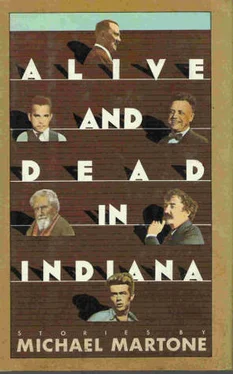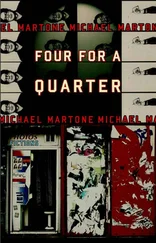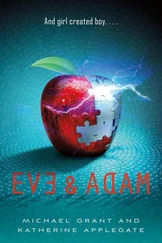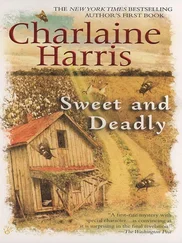Michael Martone - Alive and Dead in Indiana
Здесь есть возможность читать онлайн «Michael Martone - Alive and Dead in Indiana» весь текст электронной книги совершенно бесплатно (целиком полную версию без сокращений). В некоторых случаях можно слушать аудио, скачать через торрент в формате fb2 и присутствует краткое содержание. Год выпуска: 1984, ISBN: 1984, Издательство: Dzanc Books, Жанр: Современная проза, на английском языке. Описание произведения, (предисловие) а так же отзывы посетителей доступны на портале библиотеки ЛибКат.
- Название:Alive and Dead in Indiana
- Автор:
- Издательство:Dzanc Books
- Жанр:
- Год:1984
- ISBN:9781936873500
- Рейтинг книги:3 / 5. Голосов: 1
-
Избранное:Добавить в избранное
- Отзывы:
-
Ваша оценка:
- 60
- 1
- 2
- 3
- 4
- 5
Alive and Dead in Indiana: краткое содержание, описание и аннотация
Предлагаем к чтению аннотацию, описание, краткое содержание или предисловие (зависит от того, что написал сам автор книги «Alive and Dead in Indiana»). Если вы не нашли необходимую информацию о книге — напишите в комментариях, мы постараемся отыскать её.
Alive and Dead in Indiana — читать онлайн бесплатно полную книгу (весь текст) целиком
Ниже представлен текст книги, разбитый по страницам. Система сохранения места последней прочитанной страницы, позволяет с удобством читать онлайн бесплатно книгу «Alive and Dead in Indiana», без необходимости каждый раз заново искать на чём Вы остановились. Поставьте закладку, и сможете в любой момент перейти на страницу, на которой закончили чтение.
Интервал:
Закладка:
What are they looking for?
Something new is in the world.
There was a Looney Tunes cartoon Engineer John showed almost every day on his TV show. It was made during the war. Hitler, upset with the way the war is going, flies a mission himself, only to have the plane dismantled over Russia by “Gremlins from the Kremlin.”
I would look through the scrapbooks to see how it really happened.
There has been a plane circling all day. There appears to be a streak of smoke coming from its tail. But I’m sure it’s some kind of banner too high to read.
In the scrapbook with the wood cover, there is a picture of Gypsy Rose Lee selling war bonds.
This is the only picture in all of Grandfather’s scrap-books where he’s made a note. It says: I bet the Lord is pleased .
During the war, the top hemisphere of the streetlight globes were painted with a black opaque glaze. They stayed that way after the war. No one seems to mind. Parts of dead insects show in the lower half of the globe. There’s more and more of them in there summer after summer.
Grandfather read meters for his living. During the war, he was made block warden because everyone remembered the way he’d kept calm during The War of the Worlds . They also figured that he knew a little bit about electricity.
The city practiced blackouts all the time because they’d heard that Fort Wayne was seventh on the list. One night everyone stumbled into Hamilton Park for a demonstration. A man from the Civil Defense wanted to emphasize the importance of absolute dark, lights really out. Grandfather said that the man lit a match when the rest of the city was all dark. He said that you could see the whole park and the faces of everyone in the park. They were all looking at the match. He said you could see the houses. He said you could read the street sign. Poinsette .
The man blew out the match with one breath. The people went home in the dark.
Were they wishing they could do something about the stars?
They kept German prisoners in camps near the Nickel Plate yards. People would go out to the camps and look at the prisoners. Everyone felt very safe, even the women. Many of the prisoners had worked on streets downtown, or in the neighborhoods, and were friendly with the people.
Some of these prisoners stayed in town after the war. Some sent for their families. You ask them, they’ll tell you — Fort Wayne is a good place to live.
In one of Grandfather’s scrapbooks, there is a series of pictures taken from the nose of a B-17. The first picture is of the bombs falling away from the plane. In the background are the city streets already burning. In the second picture, the nose of another bomber is working its way into the frame and under the bombs, smaller now by seconds. The third picture shows the plane in the path of the falling bombs. One has already taken away the stabilizer without exploding. The perspective is really terrifying. The fourth picture shows the plane skidding into its tailspin. All this time the bombs are falling. And the fifth picture is the plane falling with the bombs.
Grandfather has arranged these pictures to be read down the page. One after the other.
Casad is a GSO depot built during the war just outside of town. I go there sometimes to watch them dust the fields nearby, the fertile strip near the bend in the Maumee. High school kids race by on the township roads on their way to Ohio to drink. I don’t know if they even use Casad for anything now.
Casad was built to be confusing from the air. All you can see, even from across the road, are mounds of different-colored stones. Some of the piles are real, others are only camouflaged roofs. If you look closely at some of them, you can see a small ventilation pipe or maybe some type of window. The important things are underground. There are stories that date from the war of one-ton chunks of rubber in storage. They feared the damage that would be caused if they dropped any during transportation. Tin, copper, nickel, tungsten, and mercury were all supposed to have been stored there. From the road, quarry piles and sandpiper tents hump out of sight through the cornfield to the river.
It must all look pretty harmless from the sky.
The high school kids will stop on the way back. Late at night, they will sit on the hoods of their cars guessing which of the shadows are real. They are waiting to sober up and weave home.
Mother remembers his Prospero at the Civic Theatre. He lived here years ago. The only time I saw Robert Lansing act was on the TV show where he played the wing commander and flew B-17s. All I remember now are the shots in the cramped cockpit with the flights of bombers in the background. Most of the action took place on that tiny set, two seats and the man in the turret, aft, always moving as the actors talked or rocked from the flak or were riddled by “bandits” or feathered the number three engine.
Robert Lansing visited our high school and talked about acting. He said there was a method that allowed him to use his past experiences in new situations. He said he was afraid to fly. He told us this standing in the middle of the gym floor, targeted in the cross hairs of the time-line.
In the stores downtown, there are bowls of lemon drops and cherry drops next to the cash registers. The merchants have broken into some of the supplies of the bomb shelters in the basements of their stores. They found that the water had soured years ago in the tins. The candy is sweet even though it is over twenty years old. They say the candy and water have been replaced in the bomb shelters. “No sense letting anything go to waste,” they say. Every time you buy something, the person running the register will say, “Have some candy.” And then they will mention where the candy comes from.
The small drums the candy came in are being used as wastebaskets. They are painted drab. Sometimes, the stenciled CANDY has been crossed out. The Civil Defense emblem can still be seen — the pyramid in the circle, pointing up to the sky.
Grandfather saw Bob Hope in the coffee shop of the Hotel Anthony. He showed him the clipping he had been carrying around for years, the one about Mother dancing in Bob Hope’s show. Grandfather said that he wished Bob Hope could be home for Christmas but was grateful that someone did what Bob Hope did.
In the fall, the wind turns the trees to silent puffs of smoke.
Grandfather wants to know why I want to be a poet. He shows me a clipping of Eldon Lapp, who goes to our church. There is a picture of Eldon in his flight jacket and soft hat. During the war, Eldon was shot down over Germany. Before his capture, he lived for months in the Black Forest. He survived that long with the aid of another flyer who had been trained as a Boy Scout and had been in Germany during a world jamboree. This flyer knew all the tricks — how to fish with a line and makeshift hook, how to conceal a trail, how to secure a camp, how to read signs. Eldon swore then that if he got out of this alive he would dedicate his life to scouting.
“That’s vocation,” Grandfather says to me.
The Kiwanis Club sponsors airplane rides all summer. Taking off from Baer Field, the tour flies over most of the city. I saw the Wayne Knitting Mill’s tall smokestack, Wayne built right into the bricks. I flew by the elevators, followed Main Street downtown and circled the courthouse. Then over the Old Fort, looking defenseless, and the filtration plant with the ponds. I followed the Maumee from the three rivers downstream, sweeping by the old Studebaker plant, Zollner Piston, all the wire-and-die works, Magnavox. Then banking up the bypass, north, over the shopping centers and malls and their parking lots, over Eckrich and the campus, to my house.
I could see my house. I knew it even from the air. There were people in the front yard I did not know, looking up, shielding their eyes, waving.
Читать дальшеИнтервал:
Закладка:
Похожие книги на «Alive and Dead in Indiana»
Представляем Вашему вниманию похожие книги на «Alive and Dead in Indiana» списком для выбора. Мы отобрали схожую по названию и смыслу литературу в надежде предоставить читателям больше вариантов отыскать новые, интересные, ещё непрочитанные произведения.
Обсуждение, отзывы о книге «Alive and Dead in Indiana» и просто собственные мнения читателей. Оставьте ваши комментарии, напишите, что Вы думаете о произведении, его смысле или главных героях. Укажите что конкретно понравилось, а что нет, и почему Вы так считаете.












